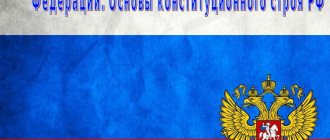Symbolism
| It turns out that the coat of arms of the Russian Federation is a fractal. On the scepter there is an eagle holding a scepter, which holds an eagle, etc. |
Three crowns signify the country's sovereignty. The scepter and orb are a symbol of state power and the unity of the state. The author of the most common image of the coat of arms of the Russian Federation is People's Artist Evgeniy Ilyich Ukhnalev. The symbol of the double-headed eagle first appeared in the history of Russia in 1497, although it was found on Tver coins even earlier. The double-headed eagle is a symbol of the Byzantine Empire. The borrowing of this symbol, as well as from Serbia, Albania from Byzantium, is explained by economic, diplomatic, as well as cultural proximity. The heraldic shield became red for the reason that the image of an eagle on red belongs to the Byzantine heraldic tradition, and the image of an eagle on yellow is closer to the Roman heraldic tradition (coat of arms of the Holy Roman Empire).
The meaning of the coat of arms of the Russian Federation
The modern coat of arms is a combination of many elements from past images. It personifies the strength of the country, its unity and centuries-old history. Three rows of feathers are a combination of goodness, truth and beauty.
An interesting fact about the scepter is that it depicts the exact same eagle holding a scepter. This reflects the infinity and future of Russia. The coat of arms consists of interconnected elements.
The coat of arms of Russia is one of the basic symbols of the country. Every element is thoughtful and has deep meaning. To study, one must turn not only to the meanings of the elements, but also to the history of the formation of Russia. The origin of the decryption is associated with the imperial period.
History of the origin of the coat of arms of Russia
Coat of arms of Russia 1497
The process of uniting the disparate principalities began before John III. It was his father, Vasily II Vasilyevich (ruled from 1435 to 1462), who began the process of unifying Russian lands.
Under John III of Moscow, the principality finally gained strength and subjugated Pskov, Novgorod, and Ryazan. During this period, Tver significantly weakened as a center for the unification of lands.
During the reign of John III, the traditions of government began to change. All the nobility in the subject lands lost their privileges. It was during the reign of John III that the veche bell of Novgorod was dismantled and brought to Moscow.
John III also built a new diplomatic policy. He took the title "Sovereign of All Rus'".
| Interesting fact |
| In the XIV-XV centuries, the signs on seals changed quite often. The princes changed the images of horsemen at their own request. Until 1497, the horseman was the main image on seals and coins. So the horseman could be with a sword (“swordsman”), with a spear in his hand (“spearman”), with a falcon in his hand (“falconer”). During the reign of Vasily the Dark, the “spearman” was established - symbolizing St. George the Victorious. |
During this period, John III marries the Byzantine queen Sophia (Zinaida) Fominichna Palaiologos.
“John III wisely adopted for Russia the symbolic coat of arms of the Byzantine Empire: a black double-headed eagle on a yellow field and combined it with the Moscow coat of arms - a horseman (St. George) in white clothes on a white horse, slaying a serpent. The state emblem, according to state law, is recognized as a symbol, a visible distinctive sign of the state itself, emblematically depicted on the state seal, on a coin, on a banner, etc. And as such a symbol, the coat of arms of the state expresses the distinctive idea and principles that the state considers itself called upon to implement.
Due to the use by Tsar John III of the Byzantine coat of arms together with the Moscow coat of arms on the seals of internal and external state acts that have been preserved since 1497, this year is generally considered to be the year of the adoption and merger of the coat of arms of the Byzantine Empire with the coat of arms of the Russian kingdom.” /E.N. Voronets. Kharkiv. 1912/
Thus, the coat of arms appeared at the moment of the emergence of the modern Russian state.
It is definitely impossible to say that the coat of arms appeared in 1497, since the matrices for printing coins lasted for 5-15 years. On a coin from 1497, a spearman was reflected on one side, and a double-headed eagle on the other. But we can say for sure that this period can be limited from 1490 to 1500.
Theories of the appearance of the double-headed eagle in Russia as an official symbol
There are several points of view on the appearance of images of a double-headed eagle in Russia (Rus). Firstly, the eagle was originally used on coins and seals of Tver and Moscow. Secondly, the eagle began to be used at approximately the same time - approximately the end of the 15th century, together with images of a spearman.
Currently, there are three theories explaining the appearance of the double-headed eagle on the seals of kings.
Byzantine theory
This theory was actively supported by Russian monarchists and many historians. In most sources it remains the only one. According to this theory, the double-headed eagle began to be used after the marriage of John III with the Byzantine queen Sophia (Zinaida) Fominichna Palaeologus.
| Coat of arms of Palaiologos |
This theory is also supported by the fact that the marriage of the monarchs coincided with the appearance in Rus' of coins combining the image of a spearman on one side and a double-headed eagle on the other.
Theory of symbol borrowing in the Holy Roman Empire
In the Holy Roman Empire until 1440, a regular eagle was used. After this period it changes to a double-headed eagle.
Some historians and heraldists note that in Muscovy the double-headed eagle could have been adopted for use under the influence of the Holy Roman Empire.
The theory of symbol borrowing in the Balkan countries
The third version of the borrowing of the symbol is the borrowing of the double-headed eagle from a number of Balkan countries: Bulgaria, Serbia.
Each of the theories has its own right to exist.
You can read more about the appearance of the double-headed eagle on the coats of arms of the world in a separate article: eagle in heraldry.
Coat of arms of Russia 1539
Since 1539, Russian heraldry has been influenced by the Central European heraldic tradition. In accordance with it, the eagle’s beaks are open and its tongue is sticking out. This position of the bird is called: “armed”
Coat of arms of Russia 1560
During this period, the double-headed eagle was transferred from the reverse of the seal to the obverse. Its meaning is fixed in Russian heraldry.
On the reverse side, a mythological animal appears for the first time: the unicorn.
Coat of arms of Russia 1562
From this period, a shield appears on the double-headed eagle’s chest (at first of a baroque heraldic form), on which there is a rider with a spear, striking a dragon on one side (the main side) and a unicorn on the shield on the other (reverse side).
Coat of arms of Russia 1577
This version of the coat of arms differs from the previous one in that there is now one jagged crown above the eagle’s heads, which symbolizes the unity and supremacy of the Moscow Prince Ivan IV the Terrible over the Russian lands.
On this seal, on each side there are emblems of 12 Russian lands (in total, 24 emblems on both sides).
Unicorn on state seals
The unicorn first appeared as one of the symbols of state power in 1560. The meaning of this symbol is still not clear. It appeared on state seals several more times - during the reigns of Boris Godunov, False Dmitry, Mikhail Fedorovich and Alexei Mikhailovich. After 1646 this symbol was not used.
Coat of arms of Russia 1605
During the Time of Troubles, the state emblem was brought into line with the European heraldic tradition for a short period of time. The spearman was turned to the left, and crowns were again placed above the heads of the eagles. The eagle's wings began to be depicted spread out.
Coat of arms of Russia 1654
After the end of the Time of Troubles and the reign of the new Romanov dynasty in Russia, the state seal, coat of arms and other symbols changed.
The main changes were that, in accordance with European heraldic tradition, the eagle's wings were now spread out. In accordance with Russian emblematic tradition, the spearman is turned to the right. Three crowns were finally placed above the eagle's heads. The beaks of the eagle's heads are open. The scepter and orb are clutched in the paws.
It was under Emperor Alexei Mikhailovich that a description of the state coat of arms first appeared.
“The eastern eagle shines with three crowns: Faith, Hope, Love for God. Krile is spread out - it embraces all the worlds of the end: the north, the south, from the east right up to the west, the sun is kindly covered with outstretched wings” (“Slavic Bible” 1663, poetic form of description).
The second description is given in the state normative act: the decree “On the royal title and the state seal” dated December 14, 1667:
“The double-headed eagle is the coat of arms of the Great Sovereign, Tsar and Grand Duke Alexei Mikhailovich of All Great, Little, and White Russia, the Samozherzh, His Royal Majesty of the Russian Kingdom, on which (the coat of arms - editor's note) three crowns are depicted, signifying the three great Kazan , Astrakhan, Siberian glorious kingdoms, submitting to the God-protected and highest power of His Royal Majesty the Most Gracious Sovereign and command... on the Persians (on the chest - editor's note) the image of the heir (this is how the rider was interpreted - editor's note); in the claws (claws - editor's note) a scepter and an apple (power - editor's note), and reveals the most gracious Sovereign, His Royal Majesty the Autocrat and Possessor."
Coat of arms of Russia during the reign of Peter the Great
Since 1710, the horseman on the Russian coat of arms has been increasingly associated with St. George the Victorious, and not with a simple spear-bearer. Also during the reign of Peter the Great, crowns on the eagle’s head began to be depicted in the form of imperial crowns. Petal and other crowns were no longer used from this point on.
| Matrix of the state seal 1710 Master - Haupt | Matrix of the state seal 1712 Master - Becker |
It was under Peter I that the coat of arms adopted the following color design: the double-headed eagle became black; beak, eyes, tongue, paws, golden-colored attributes; the field became golden; the affected dragon turned black; St. George the Victorious was depicted in silver. This color scheme was followed by all subsequent rulers from the House of Romanov.
Under Peter the Great, the coat of arms received its first official description. Under the leadership of Count B.Kh. von Minich can still be found today: “The State Coat of Arms in the old way: a double-headed eagle, black, on the heads of the crown, and at the top in the middle there is a large Imperial crown - gold; in the middle of that eagle is George on a white horse, defeating the serpent: the epancha (cloak - editor's note) and spear are yellow, the crown (crown crowning St. George - editor's note) is yellow, the serpent is black; the field around (that is, around the double-headed eagle - editor's note) is white, and in the middle (that is, under St. George - editor's note) is red."
In the 17th century, the state emblem underwent a large number of changes and variations.
Coats of arms of Russia under Paul I
| Coat of arms of Russia 1799 | Complete coat of arms of Russia 1800 |
After Peter the Great, the coat of arms of Russia changed significantly under Paul I. It was under this ruler that all variants of the coat of arms of Russia were unified and brought to one form
This year the Maltese cross appears on the coat of arms of Russia. This year Russia took the island of Malta under its protection. The following year, Britain captured the island. Paul ordered the transfer of the Order of Malta to Russia. The fact that the Maltese cross remained on the Russian coat of arms meant its claim to this territory.
Also, under Paul I, a full coat of arms with shield holders appeared, made in accordance with the traditions of that time. At this time, the “Manifesto on the full coat of arms of the All-Russian Empire” was prepared. The large coat of arms contained 43 coats of arms of the lands that were part of it. The archangels Michael and Gabriel became the shield holders. The manifesto never came into force for the reason that the head of state was killed.
State emblem, intended for military purposes from 1801 to 1825.
This type of coat of arms first appeared under Alexander I. It was different from the standard coat of arms. The main difference was that the coats of arms of the dependent territories (Finland, Astrakhan, Kazan, etc.) were not placed on the military coat of arms. The shield on the eagle's chest had a distinct heraldic shape from the French shield. The wings were not raised up.
Under the next emperor, Nicholas I, this tradition was consolidated.
Coat of arms of Russia from 1825 to 1855.
This coat of arms existed during the reign of Nicholas I.
Köhne reform (1857)
| Bernhard Köhne (Boris Vasilievich Köhne) |
Köhne Bernhard was born in 1817 in Berlin. In 1844 he was appointed to the position of curator of the numismatic department of the Hermitage. In 1857, Köhne was appointed head of the armorial department of the heraldry department.
The book “Armorial of the Russian Empire” (XI-XIII) was published under the editorship of Koehne.
It was Bernhard Köhne who organized the coats of arms of the territories of the Russian Empire. It is believed that it was under the influence of Koehne that the state received a new state flag, black, yellow and white. Although in fact, Koehne used only already developed historical materials (it is worth paying attention to the design of the large full coat of arms of the Russian Empire from 1800; on it, shield holders support a yellow flag with a black eagle with their free hand).
Köhne, in accordance with the heraldic tradition that had developed at that time, brought all coats of arms into conformity. The first coat of arms corrected by Koehne was the coat of arms of the Russian Empire. It was under him that three versions of the coat of arms were formed: large, medium, small.
Drawing of the coat of arms of the Russian Empire in 1856
As mentioned above, under the leadership of Köhne, the artist Alexander Fadeev created a new design of the coat of arms.
Main changes in the coat of arms:
- drawing of a double-headed eagle;
- added the number of shields (increased from six to eight) on the eagle’s wings;
- the rider slaying the dragon now faces heraldic right (towards the eagle's right wing).
Alexander I approved this coat of arms on December 8, 1856.
Coat of arms of the Russian Empire 1857
A year later, under the leadership of Köhne, the medium and large coats of arms were also prepared.
Coat of arms of the Russian Empire 1882
| Small coat of arms | Middle coat of arms | Great coat of arms |
In this coat of arms, the main elements of the coat of arms of the previous version were retained. The color of the crowns has changed - it is now silver.
A detailed list of the coats of arms of the lands that are part of the large coat of arms.
Coat of arms of 1917 (seal of the provisional government)
All attributes of monarchy were removed from the seal, and the shields were removed.
The sketch of the emblem-coat of arms was made by Vladislav Lukomsky, Sergei Troinitsky, Georgy Narbut, Ivan Bilibin.
An interesting fact is that the emblem was used on the reverse of coins issued by the Central Bank of Russia at the end of the 20th century. - beginning of XXI. Many people mistakenly consider this emblem to be the state emblem, which is a misconception.
What is depicted on the coat of arms of the Russian Federation
Each object and drawn detail is an integral part of the overall concept, embodying the unity of an independent state, its historically formed values, commitment to traditions and preservation of identity. The background base is a heraldic shield with clearly defined upper and rounded lower edges, and a pointed peak at the bottom center.
Multicolor without heraldic shield
The dominant image on the shield is a double-headed eagle with spread wings. Each head is crowned with a crown; in the top center there is a larger crown connected to two small ones - a ribbon. In the claws of the left paw the eagle holds a golden ball with a cross, called an orb, and the claws of the right claw grip a shortened staff.
Interesting: due to the features of the upper end of the scepter, the coat of arms of Russia can justifiably be called a real fractal. The oldest symbol of power is again crowned by a double-headed eagle, identical in appearance to the larger one depicted on the shield. An interesting feature, displaying a pronounced similar set, has elevated the coat of arms of the Russian Federation to the status of the most fractal in the whole world.
On the chest, between the outstretched eagle wings, is depicted another shield, identical in shape to the base one, on it is a plot composition in the form of a horseman striking a dragon with a spear. The defeated mythical monster lies on its back under the hooves of a horse.
Sources
- Coats of arms of cities, provinces, regions and towns of the Russian Empire, included in the complete collection of laws from 1649 to 1900/ compiled. P. P. von-Winkler;
- Coats of arms and symbols of the Belgorod region;
- State symbols of Russia (kremlin.ru);
- “How the black, yellow and white colors of Russian heraldic symbolization came about and what they mean” Explained by E.N. Voronets. Kharkiv. 1912
- Manifesto of Emperor Paul I on the full coat of arms of the All-Russian Empire. Approved December 16, 1800;
- Website of the Heraldic Council under the President of the Russian Federation;
- Decree of the President of the Russian Federation of November 30, 1993 N 2050 (as amended on September 25, 1999);
- Decree “On the royal title and the state seal” of December 14, 1667.
- "Encyclopedic Dictionary of Brockhaus and Efron."
- Some of the photographs were provided by Oransky A.V. and is prohibited from copying.







